Recent Posts
-
IDR 650K
Per Person
Ubud Tour
Welcome to Ubud Tour package. Discover the stunning beauty and rich culture of this one of Bali’s most popular destinations. Our tours aim to give you a comprehensive experience of Ubud, from traditional dances and handicrafts to stunning natural scenery.
Located in the heart of Bali, Ubud is often referred to as the ‘cultural center’ of the island. Surrounded by rice fields and lush rainforests, the city exudes a calm and peaceful atmosphere that attracts tourists from all over the world. Ubud is also known for its rich history, which is reflected in the many temples, palaces, and museums located throughout the city. The Ubud Tour Package is the perfect way to explore this vibrant city and experience its unique culture. We have carefully put together an Ubud tour itinerary that includes some of Ubud’s must-see attractions, each with its own special meaning. From Barong and Keris dance performances to the Ubud market, you can experience the best of Ubud in just one day.
Your knowledgeable tour guide will provide you with detailed information about Ubud’s history and culture, allowing you to learn about each destination on a deeper level. Whether you are interested in traditional handicrafts, stunning natural scenery, or Balinese history and culture, our Ubud tour packages have something for everyone. Join this unforgettable Ubud tour and experience the beauty and culture of one of Bali’s most fascinating cities. We can’t wait to show you what makes Ubud so special!
Place to Visit
Barong and Keris Dance Performance
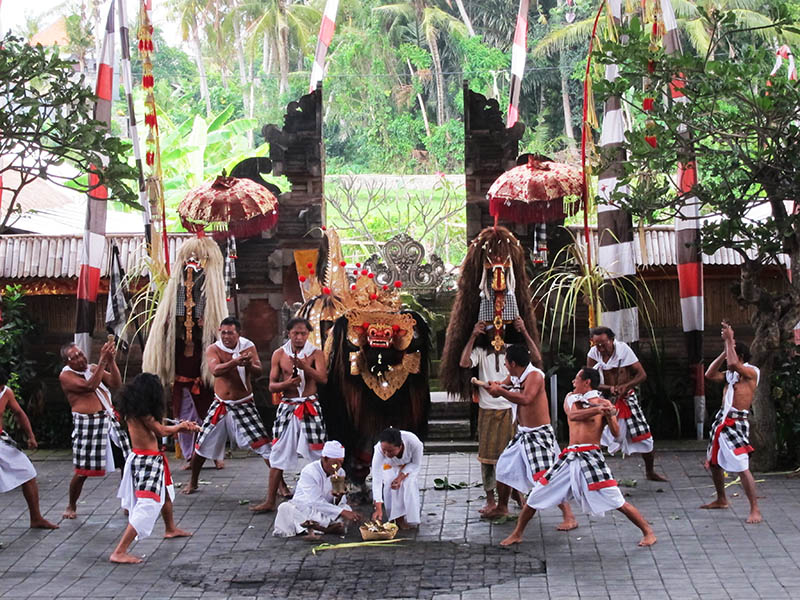
The Barong and Keris dance performance is a traditional Balinese dance and is considered one of the most important cultural performances on the island. This dance performance is usually performed in temples and public places during traditional ceremonies, festivals, or special occasions.
Barong is a mythical creature representing good in Balinese mythology and Keris is a traditional Indonesian dagger representing evil. The dance is a battle between Barong and Keris, and Barong tries to protect people from Keris’ malice. Performances typically begin with character introductions, followed by a battle between Barong and Keris. The dance is accompanied by traditional Balinese music played on gamelan instruments, further enhancing the magical atmosphere of the performance. The dancers wear elaborate costumes and their movements are graceful and synchronized.
Celuk Village
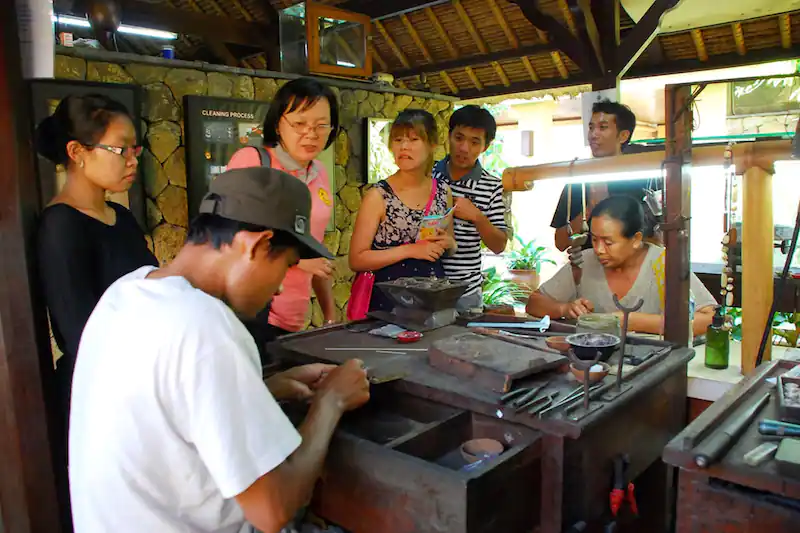
Celuk Village is a must-visit destination for those who are interested in Balinese culture and traditional crafts. This small village is known for its silver and gold jewelry, which has been made here for generations.
The village is located in the Gianyar Regency, approximately 5 km from the center of Ubud. It’s easily accessible by car or motorbike, and there are plenty of parking spaces available. Once you arrive, you’ll notice that most of the shops in the village specialize in silver and gold jewelry making.
The traditional jewelry-making process is fascinating to watch. You’ll see skilled artisans working with a range of tools, such as hammers, pliers, and filers, to shape the metal into intricate designs. They use traditional techniques such as hand engraving, filigree, and granulation to create beautiful pieces of jewelry that are unique to the village.
If you’re interested in purchasing souvenirs, this is the perfect place to do so. You’ll find a wide variety of jewelry items, including earrings, necklaces, bracelets, and rings, all at reasonable prices. Most of the shops also offer custom-made jewelry, so you can even design your own unique piece.
It’s recommended to spend at least an hour in the village to explore and shop around. You’ll have the opportunity to browse through the different shops, watch the artisans at work, and even try your hand at making jewelry yourself.
Tegenungan Waterfall
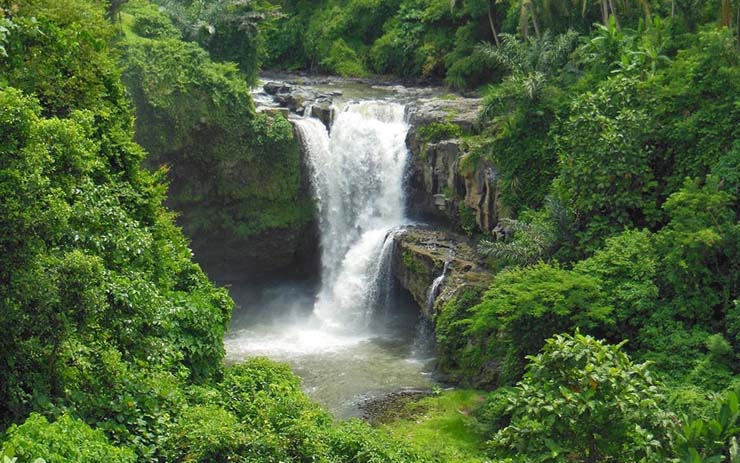
One of Bali’s most stunning waterfalls, Tegenungan Waterfall is situated in the Tegenungan area. Its outstanding natural beauty is created by its location in a luxuriant jungle environment, which is surrounded by vegetation and rocks.
The waterfall is only around 10 km from the city of Ubud and is conveniently reachable by vehicle or motorcycle. The waterfall is only a short distance away from there through a staircase.
It’s crucial to wear comfortable shoes and use caution because the descent to the waterfall might be rather arduous. The journey is worthwhile, though, because of the stunning landscape along the way. A breathtaking view of the waterfall pouring down from a height of around 15 meters awaits you once you reach the bottom.
The chance to swim and unwind in the cold, soothing water of Ubud Tegenungan Waterfall is one of its best features. Visitors can swim and enjoy the natural beauty of the surroundings in a tiny pool at the base of the waterfall. It’s vital to keep in mind that the water can be rather deep, therefore being a confident swimmer is advised.
Plan on spending at least an hour or two swimming and relaxing in order to really enjoy the waterfall experience. Furthermore close are a few little cafés and food stands where you may have a snack or drink.
The Tegenungan Waterfall is a stunning and tranquil natural sight that should not be overlooked when joining the Ubud tour. It’s the ideal place to relax and get in touch with nature thanks to the breathtaking environment, swimming, and relaxing options.
Tegalalang Rice Terrace
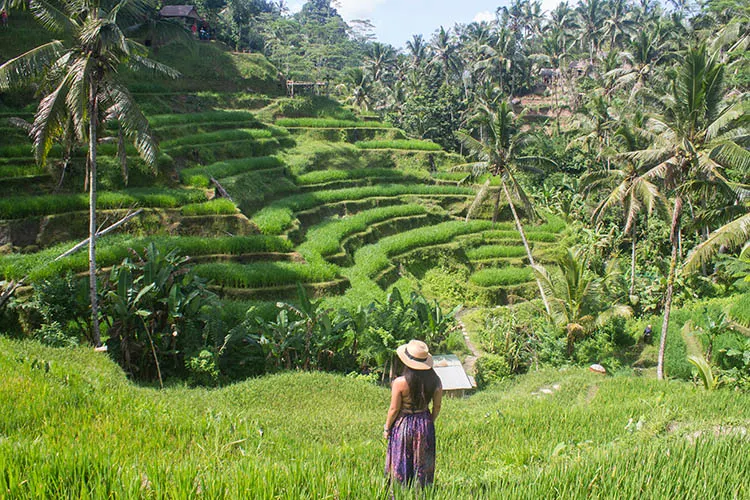
The Tegalalang rice terrace is one of Bali’s most famous and beautiful landscapes. The island’s long history of rice farming is attested to by the rice terraces, a cultural icon of Bali.
A complex irrigation system that has been passed down through generations of Balinese farmers was used to build the rice terraces. The method uses small channels to redirect water from rivers and streams into rice paddies. The procedure makes sure that the rice paddies have the right amount of water and nutrients for growing strong crops.
Visitors to the Tegalalang Rice Terrace have the chance to tour the terraces and discover how rice is traditionally farmed. The scenery makes for a beautiful backdrop for photos, thus there are numerous photo chances accessible.
There is an optional activity—the traditional Balinese swing—available for those seeking a distinctive experience. Visitors may swing above the rice terraces and take in the beautiful vistas from a unique vantage point thanks to the swing’s bamboo and rope construction.
It is advised to set aside at least an hour or two to tour the rice terraces and appreciate the natural beauty of the area. Also close are a number of local cafes and gift shops where tourists may try local food and buy souvenirs.
In general, those who are interested in Balinese culture and natural beauty should visit the Ubud Tegalalang rice terrace. It’s the ideal place to unwind and interact with the island’s rich cultural heritage thanks to its fascinating history, beautiful landscapes, and intriguing optional activity.
Ubud Monkey Forest
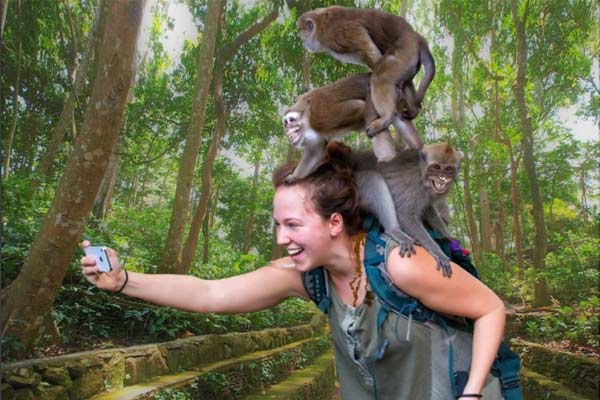
The Ubud Monkey Forest is a sanctuary in the center of Ubud where a robust monkey population lives. The park, a well-liked tourist destination, gives guests the chance to get up and personal with these amusing animals.
More than 700 Balinese long-tailed macaques, a local type of monkey, reside in the sanctuary. Visitors are cautioned to keep their distance from the monkeys and to refrain from petting or establishing eye contact with them. While being friendly in general, monkeys are still wild animals and can become hostile if provoked.
The park and its several temples, which are steeped in Balinese culture and history, may be explored by visitors. The temples are ornately carved and sculptured, providing tourists with an insight into the island’s rich spiritual tradition.
There are various spots within the park where visitors may rest and relax while watching the monkeys in their natural environment. The park also has a peaceful and beautiful atmosphere, making it a great place to relax and get away from the rush and bustle of Ubud.
It is suggested that you spend at least an hour or two exploring the park and observing the monkeys. Visitors should also observe the instructions for engaging with the monkeys to guarantee both their own and the animals’ safety.
Ubud Royal Palace
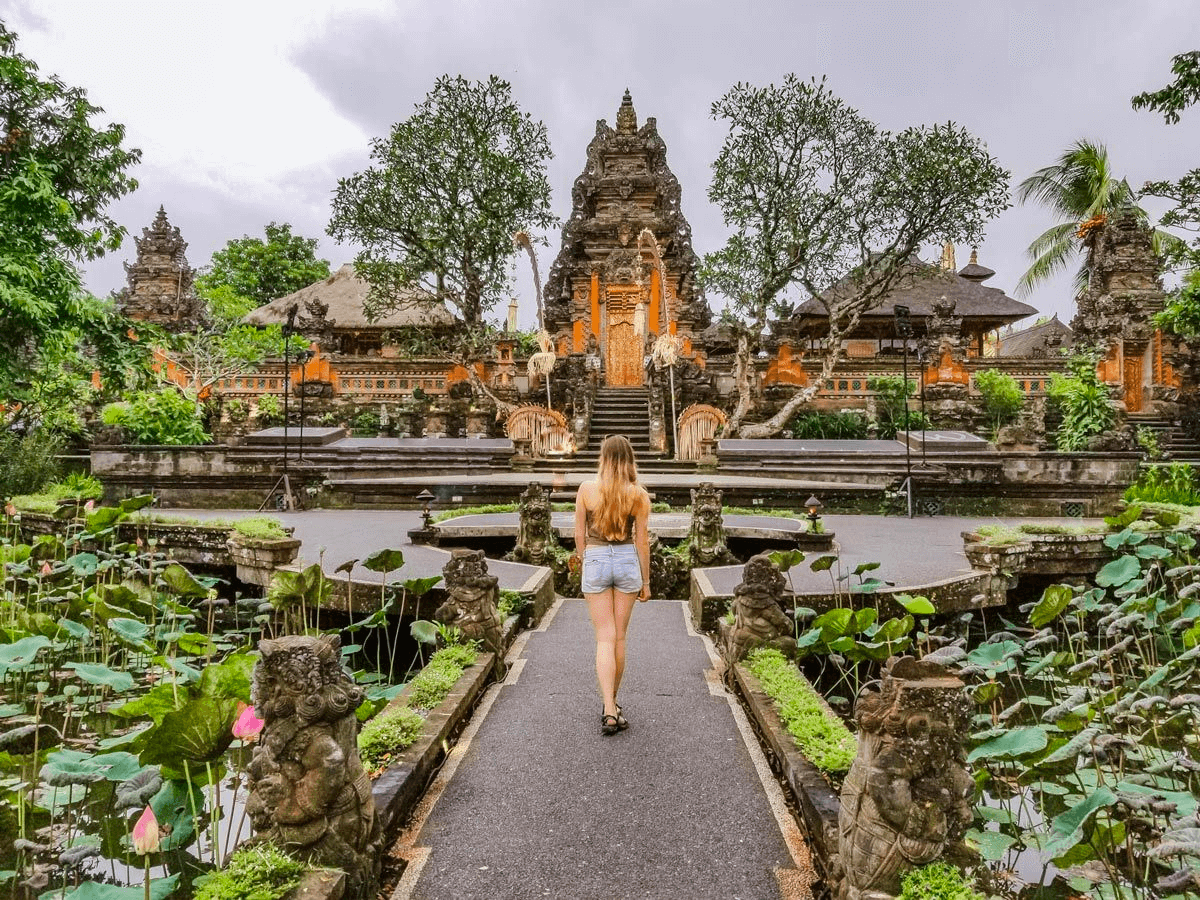
The Puri Saren Ubud, commonly known as the Ubud Royal Palace, is a historical and cultural monument in the middle of Ubud. The palace was built in the early nineteenth century and housed the Ubud royal family until the 1940s.
The palace is famous for its one-of-a-kind and ornate architecture, which combines Balinese and European design elements. Beautiful gardens, exquisite carvings, and intricate stone sculptures surround the palace grounds, highlighting the island’s rich creative legacy.
Guests can wander the palace grounds and observe the spectacular architecture and decor. The palace also includes a museum with a collection of historical items and art pieces that provide insight into Bali’s rich cultural history.
The traditional Balinese dance performances conducted in the evenings are one of the palace’s highlights. These performances highlight the island’s colorful culture and are a must-see for tourists to Ubud.
Visitors should allow at least an hour or two to explore the palace and its grounds. The palace also provides various photo opportunities, so tourists should bring their cameras to capture the spectacular architecture and decor.
Ubud Market
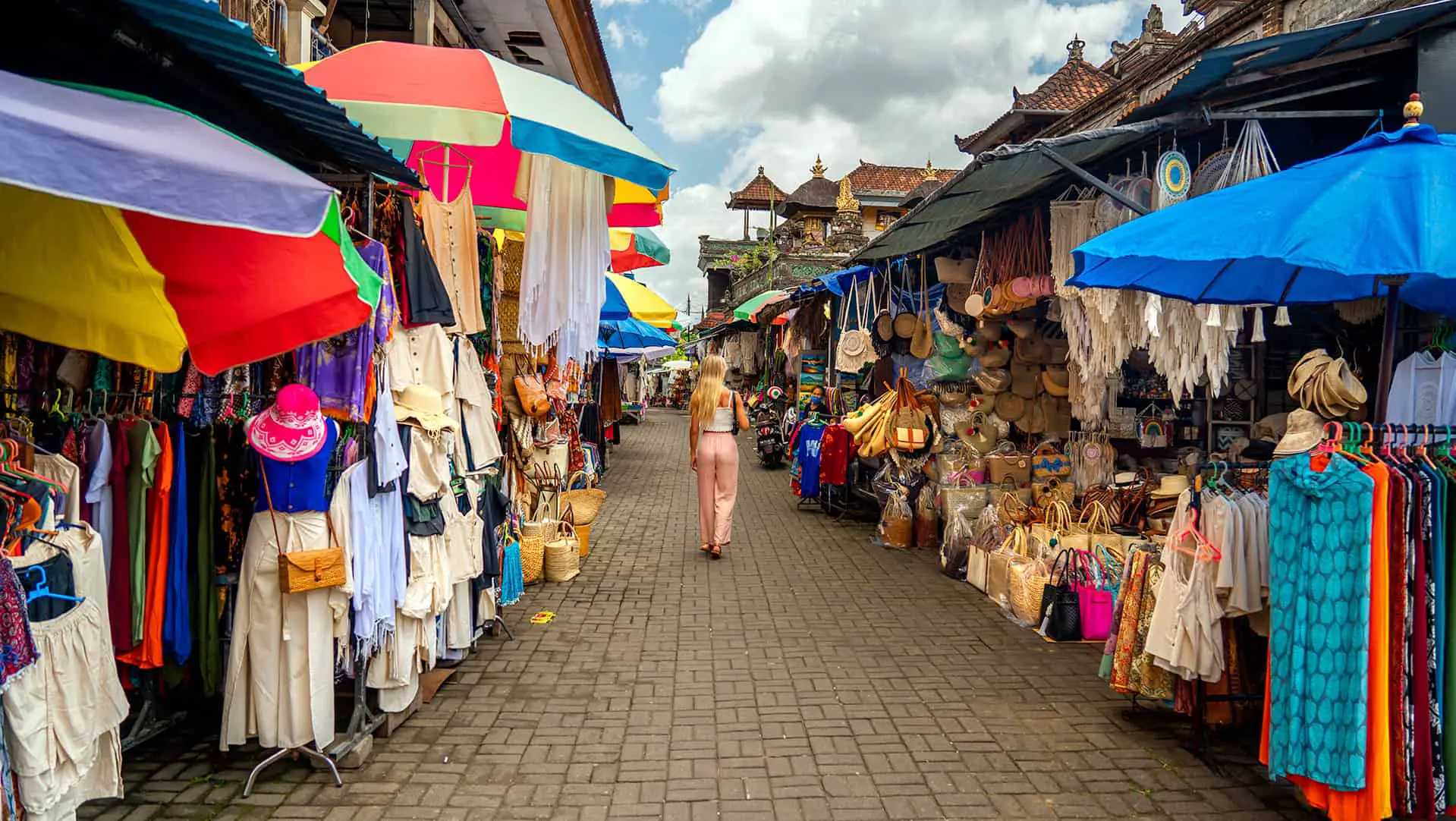
Ubud Market is a vibrant and bustling market in the heart of Ubud. A market is a popular place for tourists looking to buy souvenirs and local handicrafts.
The market offers a wide range of products including traditional Balinese clothing, batik fabrics, jewelry, wood carvings, and handicrafts. Visitors can browse the stalls and find unique and authentic souvenirs to take home.
The market is divided into two areas of the traditional market and the art market. A traditional market is located in front of the market and stocks local produce and household goods. The Art Market is located behind the market and sells traditional handicrafts and souvenirs.
Visitors should allow at least 1-2 hours to explore the market and peruse the stalls. The market can get very crowded, so visitors should be prepared to avoid crowds and bargain with vendors.
When shopping at the market, visitors should be prepared to bargain with vendors to get the best prices for their purchases. It’s also important to keep an eye on your belongings and watch out for pickpockets in crowded markets.
Overall, Ubud Market is a must-see for anyone wanting to experience Bali’s vibrant culture and purchase unique souvenirs and handicrafts. The market offers a glimpse into the island’s rich artistic heritage and a visit We provide customers with an unforgettable shopping experience.
Looking for a way to experience the beauty, culture, and magic of Bali? This Ubud tour is carefully crafted to take you on a journey through some of the most enchanting and memorable locations in the region.
Don’t miss out on this once-in-a-lifetime experience. Book the Ubud tour now and get ready for an adventure you’ll never forget!
Ubud Tours Itinerary
08:00 – Pick up at the hotel
09.30 – Watching Barong and Keris and Dance Performance (Trance Dance)
11.00 – Visit Celuk Village for Traditional Gold and Silver Smith
12.00 – Visit Ubud Tegenungan Waterfall
13.00 – Enjoy Lunch in Ubud
14.30 – Visit Ubud Tegalalang Rice Terrace
15.30 – Visit Ubud Monkey Forest
16.00 – Visit Ubud Royal Palace
16.30 – Visit Ubud Market
17.30 – Back to the hotel
18.30 – Arrive at the hotel
Area Covered for Pick Up
Seminyak, Legian, Kuta, Nusa Dua, Jimbaran, Pecatu, Sanur, Ubud, Canggu, Denpasar, Benoa Harbour, Airport.
Please contact us for pick up in the different area.
Booking and Payment
- Fill in and submit the booking form
- Payment is Cash to your driver
-
DepartureHotel/ Villa
-
Departure Time8:00 AM
-
Return Time6:30 PM
-
IncludedPrivate tourComfortable Car with Air ConditionerSpeaking English DriverPetrol for carLunch at Ubud restaurant (set menu)Entrance Fee TicketsMineral waterParking feesGovernment taxes
-
Not IncludedPersonal expenses
Similar Tours
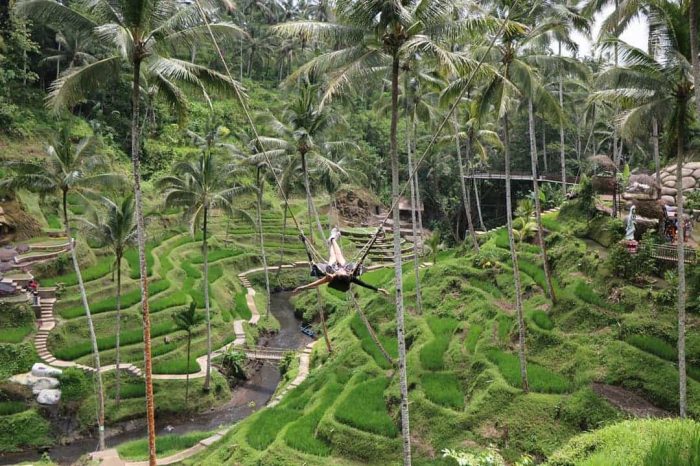
IDR 650K
Bali Swing Tour and Ubud Tour
A thrilling adventure activity that has grown tremendously popular among visitors to Bali is the Bali Swing Tour. Visitors are led on a tour to a spot where a huge swing has been erected between two big trees, offering breathtaking views of the surrounding jungle and rice terraces. Visitors can swing alone or with a partner; the swing is often composed of sturdy ropes. Swinging above the earth while seeing the gorgeous surroundings is a thrilling experience.
Often, the Bali Swing Tour includes extra excursions like zip lining, trekking, and visiting picturesque surroundings. The on-site restaurant serves a range of regional and foreign cuisine, and visitors may also have a delectable lunch or snack there.
The Ubud Tour, on the other hand, is a cultural and sightseeing tour that takes travelers to Ubud, a town noted for its rich cultural legacy and stunning scenery. The town is located in the center portion of Bali, and it is generally referred to as the cultural heart of the island. Visits to historic temples, rice terraces, art galleries, and traditional Balinese communities are common on the Ubud Tour.
The Monkey Forest, a sanctuary for the Balinese long-tailed monkey, is one of the highlights of the Ubud Tour. Guests can view and even feed the monkeys in their natural habitat.
The Ubud Tour is an excellent way to immerse yourself in local culture while also experiencing Bali’s natural beauty. Visitors can watch traditional dance performances, learn about the region’s traditional handicrafts and art, and even try their hand at some Balinese crafts. Stops at local markets and stores let visitors purchase souvenirs and other traditional Balinese products.
The Bali Swing Tour and Ubud Tour provide travelers visiting Bali with one-of-a-kind and amazing experiences. These trips are a terrific way to see the beauty and diversity of this amazing island, whether you’re looking for adventure or cultural immersion.
Place to Visit
Bali Swing Tour
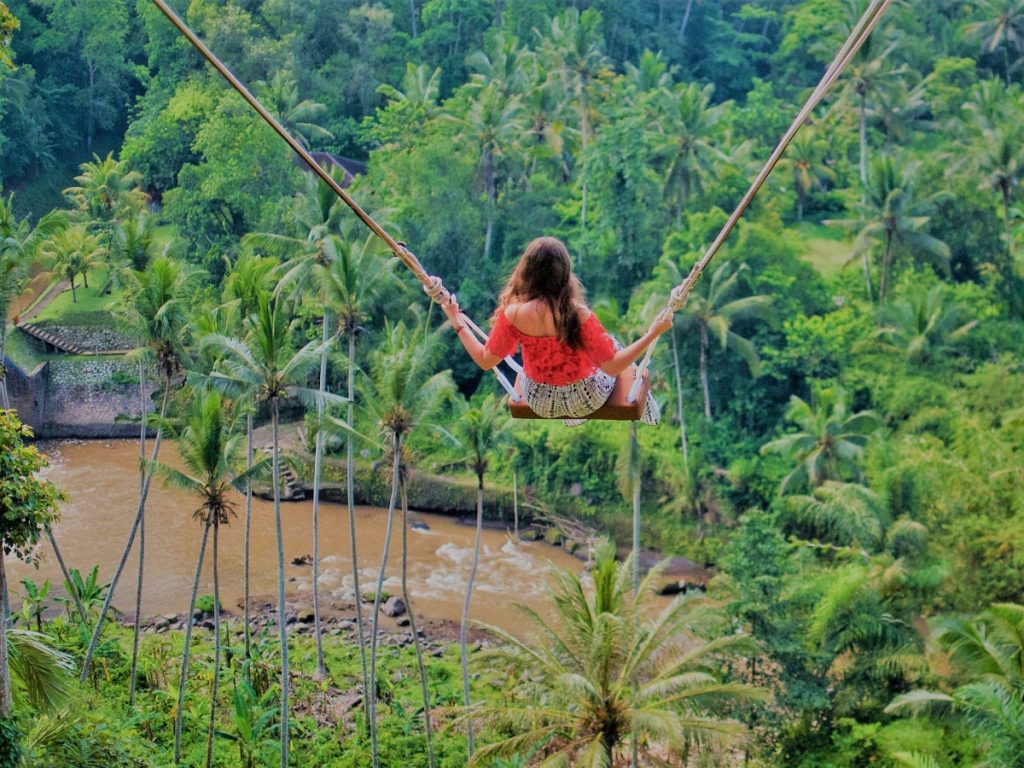
The Bali Swing Tour is an extremely popular adventure activity among tourists visiting Bali, Indonesia. It is a once-in-a-lifetime opportunity for guests to swing far above the beautiful green jungle and rice terraces, with breathtaking views of the surrounding countryside. In this overview, we will go through the Bali Swing Tour in depth.
During a standard Bali Swing Tour, a large swing is built between two large trees in a gorgeous setting. The swing, which is typically hanging over a cliff or a valley and composed of sturdy ropes, gives users an exhilarating sensation as they soar above the earth. It is the ideal place for selfies and photos since it provides stunning views of the nearby forest, rice terraces, and rivers.
A range of swings, including single swings, tandem swings, and swings big enough to fit groups of people, are available for guests to select from on the Bali Swing Tour. All ages of visitors are catered for by the swings, and safety precautions are taken to guarantee that swinging guests are secure.
The Bali Swing Tour often includes other activities in addition to swinging, such as zip lining, trekking, and taking in the breathtaking scenery. The on-site restaurant, which serves a range of regional and international cuisine, also welcomes visitors to indulge in a tasty lunch or snack. Visitors can enjoy great views of the surrounding countryside because the restaurant is often situated in a beautiful area.
The Bali Swing Tour is a fantastic opportunity to spice up your trip to Bali and make lifelong memories. For those looking for a distinctive and exhilarating experience, it is a must-do activity. The tour may be tailored to fit varied interests and budgets and is appropriate for singletons, couples, families, and groups of friends.
The Bali Swing Tour is an adventurous activity that provides tourists with a distinctive and exhilarating experience. It offers stunning views of the surrounding area and is a wonderful opportunity to make priceless memories. The Bali Swing Tour is a must-do when in Bali, whether you’re looking for excitement, leisure, or both.
Tegalalang Rice Terrace
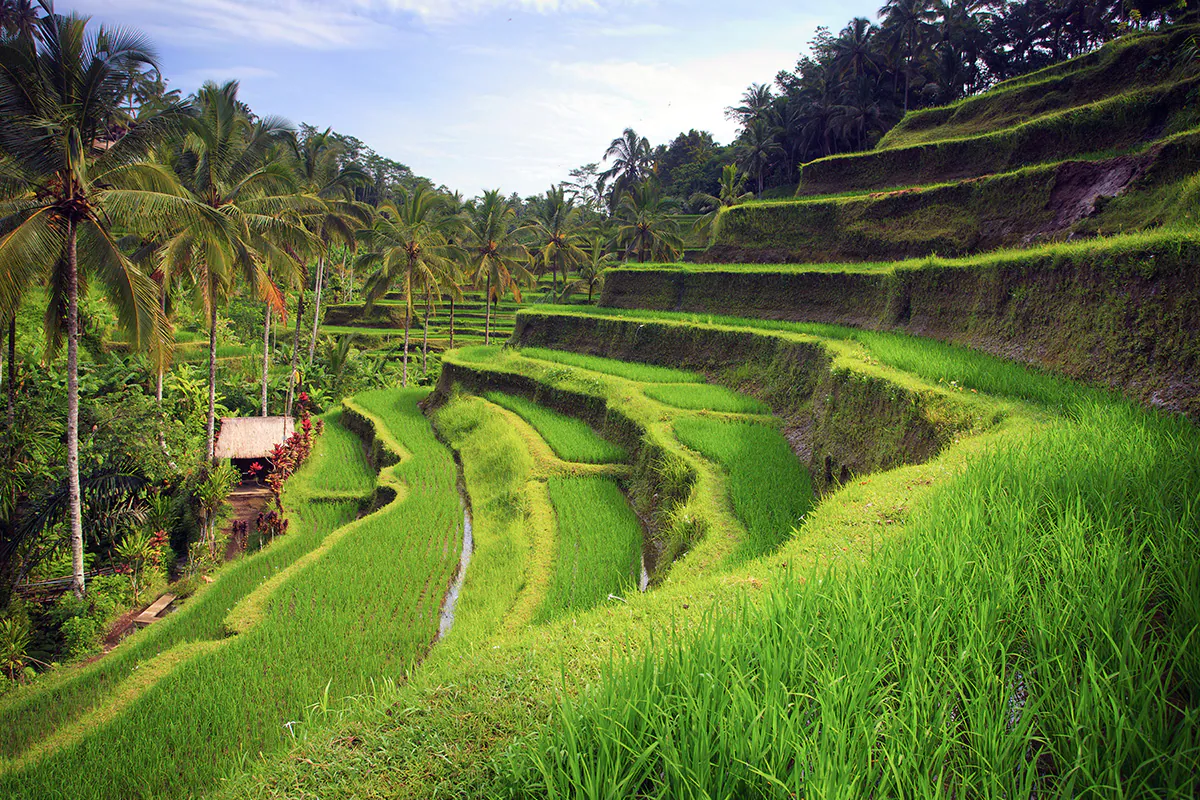
Tegallalang Rice Terrace is one of the most iconic and scenic landscapes in Bali, Indonesia. Located in Tegallalang village about 10 kilometers north of Ubud, it is one of Bali’s most popular tourist attractions. This overview details the Tegalalang Rice Terrace.
The Tegalalang Rice Terraces are vast rice fields carved into a terraced landscape. The rice terraces have been formed and maintained by generations of Balinese farmers who use a traditional irrigation system called ‘subak’ to irrigate the rice fields. A UNESCO World Heritage Site, the Subak System is an intricate network of canals and water temples used to supply water to rice fields.
Tegallalang Rice Terrace is the perfect place to experience the natural beauty and traditional culture of Bali. The terraces are set between hills and valleys, allowing visitors to take leisurely strolls through the rice fields and enjoy the fresh air and peaceful atmosphere. Especially during the rice planting and harvesting season, the rice fields are lush and green, and the scenery is spectacular.
In addition to the natural beauty of Tegalalang Rice Terrace, visitors can also learn about traditional Balinese rice cultivation methods. There are many small stalls and shops in the surrounding area, where visitors can purchase local handicrafts and souvenirs, or enjoy local cuisine at various restaurants and cafes. Visitors can also experience traditional Balinese dances and cultural events taking place in the area.
Tegalalang Rice Terrace is a must-see for anyone visiting Bali. A unique and authentic glimpse into the traditional Balinese way of life, with stunning views of the natural landscape. Whether you’re looking for a peaceful stroll through the rice fields or a cultural experience, the Tegalalang Rice Terrace is an attraction that should not be missed.
Ubud Monkey Forest

The Ubud Monkey Forest is a prominent tourist attraction located in the middle of Ubud, Bali, Indonesia. It is one of the area’s few surviving natural woods and a refuge for about 700 long-tailed macaque monkeys. We shall go further into the Ubud Monkey Forest in this overview.
In the midst of a busy Ubud, there lies a stunning and serene refuge known as the Ubud Monkey Forest. It has a surface area of around 12.5 hectares and is made up of multiple old temples, thick rainforests, and tall trees. The well-maintained walkways in the Monkey Forest allow visitors to enjoy a leisurely stroll while admiring the forest’s natural beauty and the playful monkeys living there.
Visitors are urged to use caution and abide by the park’s guidelines since the monkeys at the Ubud Monkey Forest are notorious for their cheeky and mischievous nature. Visitors should be careful with their valuables and refrain from feeding or petting the monkeys because they have been known to steal food and other stuff from unaware tourists.
The Ubud Monkey Forest is also home to a number of significant temples and historic locations in addition to the monkeys. The 14th-century temples are still in use today for everyday rites and rituals. Tourists may tour the temples and discover more about Bali’s distinctive fusion of Hinduism and animism.
For everyone visiting Bali, the Ubud Monkey Forest is a must-see attraction. It gives a special chance to see and interact with monkeys in their natural setting as well as a tranquil escape from the bustle of Ubud. The Ubud Monkey Forest is a must-see destination regardless of your interests in nature, culture, or just having a good time.
Ubud Royal Palace

The Puri Saren Agung, often referred to as the Ubud Royal Palace, is a historical palace that is situated in the heart of Ubud, Bali, Indonesia. It was constructed in the early 19th century as the royal family of Ubud’s home and is now accessible to the public as a historical and cultural attraction. We shall delve more into the Ubud Royal Palace in this overview.
A stunning illustration of traditional Balinese architecture is the Ubud Royal Palace. It is a collection of structures that also include a number of pavilions, courtyards, and gardens. High walls surround the palace, which can be entered through a magnificent gate that is manned by statues of fantastical creatures. The palace has beautiful decorations and intricate carvings that showcase the distinctive fusion of Hindu and Buddhist elements in Balinese culture.
Explore the numerous structures and gardens that make up the Ubud Royal Palace complex. Ancient statues, carvings, and fabrics, as well as other significant historical relics and cultural treasures, may be found inside the palace. Via the numerous exhibits and displays that are on show throughout the palace, visitors may also learn about the history and customs of Bali.
Ubud Royal Palace is a must-see for anyone interested in Balinese culture and history. It offers a unique opportunity to explore Bali’s rich cultural heritage and learn about the important role the royal family played in promoting and preserving this heritage. Whether you’re into history and art, or looking for a quiet retreat in the heart of Ubud, Ubud Royal Palace is an attraction not to be missed.
Ubud Market

The Ubud Market, also known as Pasar Ubud, is a thriving market in the center of Ubud, Bali, Indonesia. It is one of the largest and most popular markets in Bali and is a key draw for tourists and locals alike. In this overview, we will delve deeper into the Ubud Market.
The Ubud Market is a lively and colorful marketplace brimming with a diverse range of goods and items. Anything from traditional Balinese apparel and handicrafts to fresh fruits and vegetables, spices, and souvenirs may be found at the market. The market is separated into two sections: the traditional market, where fresh produce and household items are offered, and the art market, where handicrafts, textiles, and other souvenirs are marketed.
The opportunity to connect with local sellers and artisans is one of the highlights of the Ubud Market. Many of the merchants are accomplished artisans who handcraft their wares using traditional ways. Visitors can observe the artisans as they weave intricate textiles, carve wooden sculptures, and paint intricate designs on pottery.
The Ubud Market is a terrific spot to find one-of-a-kind and original Bali gifts. Traditional Balinese sarongs and batik textiles, as well as hand-carved masks, jewelry, and sculptures, are available to visitors. The market is also an excellent place to hone your bargaining abilities, as haggling is expected and frequently required to get the best discounts.
The Ubud Market is an excellent spot to experience local cuisine and drink in addition to shopping. Traditional Balinese food and drinks, including fresh fruit juices, coconut water, and local sweets, are available from a number of kiosks and sellers.
Everyone visiting Bali should make sure to visit the Ubud Market. It offers a special chance to get a taste of Bali’s diverse culture and customs and to meet local craftspeople and sellers. The Ubud Market is a must-see destination whether you’re looking to shop, eat, or are just there to take in the ambiance.
Tour Itinerary
08.30 – Pick up from hotel
10.00 – Enjoy Bali Swing Tour
12.00 – Lunch
13.30 – Visit Tegalalang Rice Terrace
15.00 – Visit Monkey Forest
16.00 – Visit Ubud Royal Palace
16.30 – Visit Ubud Market
17.30 – Back to the hotel
18.30 – Arrive at the hotel
Area Covered for Pick Up
Seminyak, Legian, Kuta, Nusa Dua, Jimbaran, Pecatu, Sanur, Ubud, Canggu, Denpasar, Benoa Harbour, Airport.
Please contact us for pick up in the different area.
Booking and Payment
- Fill in and submit the booking form
- Payment is Cash to your driver
1 day
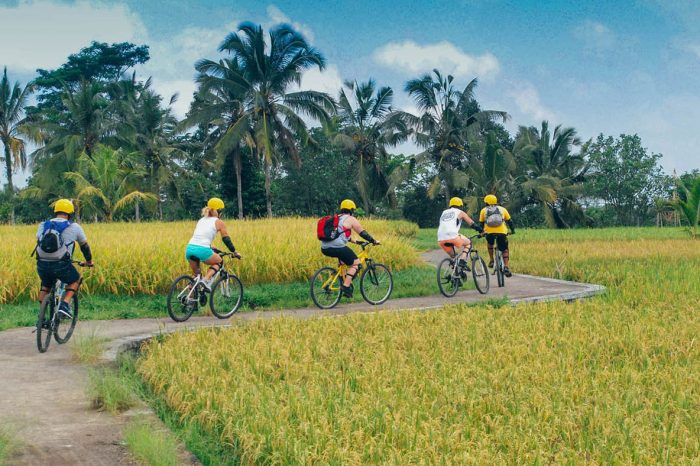
From IDR 450K
Kintamani Cycling Tour
The Kintamani cycling tour package is a popular tourist activity on the Indonesian island of Bali. It allows tourists to discover Bali’s magnificent countryside and gorgeous surroundings by cycling through villages, rice fields, and woods. The journey is ideal for nature lovers, adventure seekers, and those interested in learning about Balinese culture.
The journey normally begins with a hotel pickup, followed by a picturesque drive up to the Kintamani highlands. Visitors may enjoy a stunning view of Mount Batur, an active volcano, and the tranquil Lake Batur from here. The bike trip begins after a quick safety briefing and equipment check.
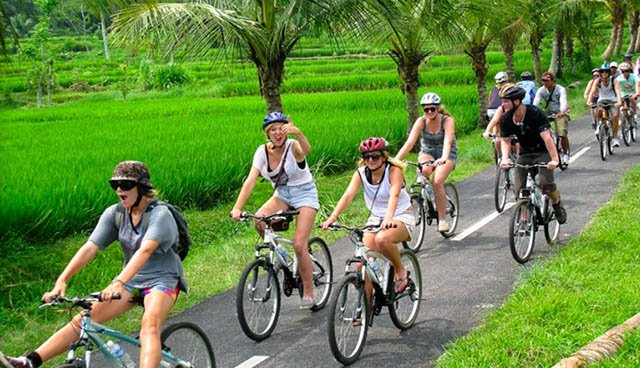
One of the tour’s highlights is a stop at a traditional Balinese home complex, where guests may get a sight of the native way of life and discover the Balinese people’s traditions and beliefs. As part of the tour, guests will also visit a coffee farm where they will get the opportunity to try some of Bali’s best coffee and tea.
Cycling through beautiful rice paddies and verdant woodlands, taking in the fresh air and breathtaking scenery, is part of the journey as it moves on. A delectable Balinese lunch and a ride back to the hotel mark the tour’s conclusion.
The Kintamani cycling tour package is a wonderful opportunity to discover Bali’s picturesque scenery and rich culture. Visitors may enjoy an exciting day of exploration and adventure with a well-thought-out itinerary and knowledgeable guides.
The Kintamani highlands are one of Bali’s most famous tourist destinations. The highlands, located at an elevation of 1,500 meters above sea level, provide tourists with a breathtaking view of Mount Batur and Lake Batur, one of Bali’s largest crater lakes.
From the Kintamani highlands, the view of Mount Batur is spectacular. Mount Batur is an active volcano that has erupted multiple times in the past, the most recent being in 2000. Mount Batur is a popular hiking destination, despite its active condition, and many people travel to Bali particularly to trek up to its peak.
Another natural beauty visible from the Kintamani highlands is Lake Batur, which is located at the base of Mount Batur. The lake is a big crater lake with a circumference of approximately 7 kilometers that is surrounded by hills and mountains. Guests may enjoy the tranquillity of the surrounding nature while taking in the placid beauty of Lake Batur from the hills.
Apart from the breathtaking views of Mount Batur and Lake Batur, the Kintamani highlands provide visitors with a cool and refreshing atmosphere that is a welcome relief from Bali’s tropical heat.
During the Kintamani cycling tour, tourists will have the option to visit a Traditional Balinese home compound, which provides insight into the Balinese people’s native culture, customs, and beliefs.
The Balinese home complex is a typical family housing characterized by its unique architecture and style. It usually consists of numerous structures, such as a main home, a family temple, a kitchen, and a rice barn. The houses are composed of wood and bamboo and have thatched roofs as well as elaborately carved doors and windows. The family temple, located in the middle of the courtyard, serves as the house’s spiritual core and is utilized for daily sacrifices and prayers.
A local family will be greeting visitors and accompanying them through the complex, providing insight into their everyday lives and rituals. Guests will learn about the significance of family and community in Balinese culture and see the traditional way of life that has been perpetuated for centuries.
Visitors to the traditional Balinese home compound can also learn about Balinese beliefs and spiritual practices. Guests will learn about the relevance of religion in Balinese culture, as well as the significance of daily offerings and rites done at the family temple.
The tour of the Balinese house complex also includes a typical Balinese lunch provided in a family-style setting. Guests will be able to sample a range of local delicacies cooked with fresh ingredients and traditional Balinese spices.
The Traditional Balinese home compound is a one-of-a-kind and enlightening experience that provides guests with an insight into the Balinese people’s lifestyle, customs, and beliefs. It is an excellent method to learn about Bali’s rich cultural heritage and to engage with the local people in a meaningful way.
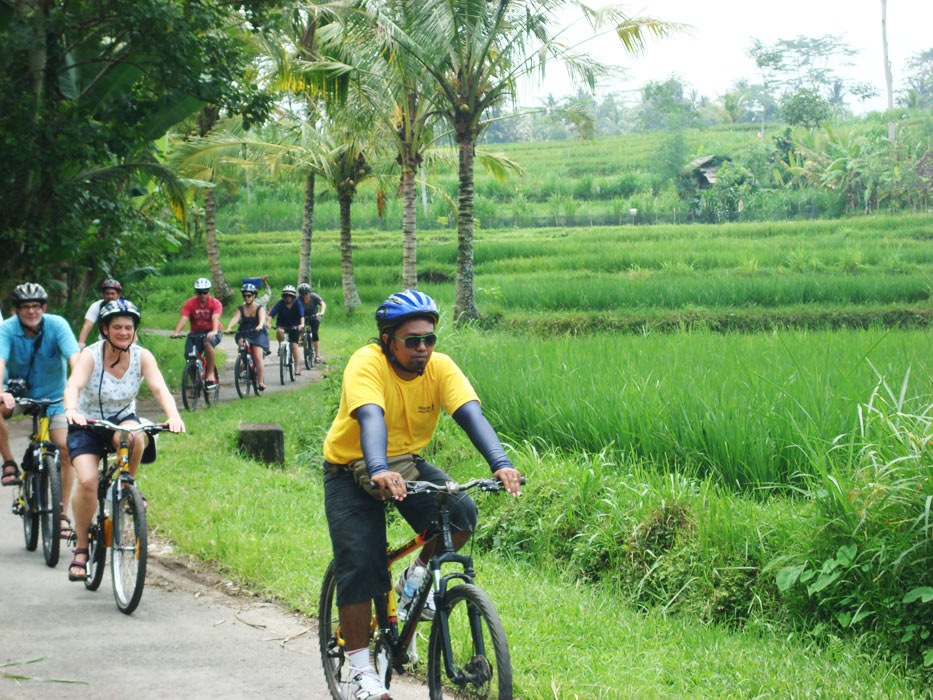
The Kintamani cycling tour takes you through the beautiful rice terraces and forests typical of the Bali scenery. The journey allows guests to take in Bali’s natural beauty while also enjoying the fresh air and tranquil ambiance of the countryside.
Bali’s rice paddies are a reflection of the island’s agricultural culture. The rice terraces are organized in a tiered pattern, creating a spectacular visual scene. Terraces are carved into the hillsides, resulting in a sequence of steps that flow down the slopes. The surrounding woodlands frame the green fields of the rice paddies, adding to the splendor of the environment.
Travelers will ride through the beautiful forests that cover most of Bali in addition to the rice terraces. The forests sustain an extensive range of plant and animal species and serve as a major source of oxygen and natural resources for the island. The journey through the trees allows tourists to take in the fresh air and relax in the calm and tranquillity of their surroundings.
The sounds of nature, such as birds singing and leaf rustling, will accompany tourists as they ride through the rice paddies and forests. The highlands’ cool and refreshing atmosphere adds to the whole experience, offering an escape from the tropical heat of the island’s coastal sections.
See Bali’s natural beauty and rich cultural legacy on the Kintamani cycling tour, a memorable journey. This tour is a must-do for anybody wanting to discover Bali’s hidden jewels since it offers breathtaking views of Mount Batur and Lake Batur, a trip to a traditional Balinese housing compound, and a ride through beautiful rice terraces and woods.
You will not only have the opportunity to see the gorgeous environment, but you will also learn about the Balinese people’s way of life, traditions, and beliefs. Your day of exploration and adventure will be made pleasant by affable and knowledgeable guides, who will also provide you with a comprehensive cultural experience.
So why wait? Discover the wonder of Bali’s scenery and culture by booking your Kintamani cycling tour right away. With so much to see and do, this tour is guaranteed to leave you with lifelong memories. Don’t pass up this chance to visit one of the most breathtaking places on earth.
Tour Itinerary
07.00 – Pick up at your hotel
09.00 – Breakfast at Kintamani with a view of Mount Batur volcano
10.00 – Go to starting point of Kintamani Cycling
10.30 – Enjoy the downhill Kintamani Cycling Tour
13.30 – Lunch
14.30 – Back to the hotel
16.00 – Arrive at the hotel
Tour Prices :
1 Person : IDR 950.000
2 Persons : IDR 700.000/person
3 Persons : IDR 600.000/person
4 Persons : IDR 550.000/person
5 Persons : IDR 500.000/person
6 Persons : IDR 450.000/person
Area Covered for Pick Up
Seminyak, Legian, Kuta, Nusa Dua, Jimbaran, Pecatu, Sanur, Ubud, Canggu, Denpasar, Benoa Harbour, Airport.
Please contact us for pick up in different area.
Booking and Payment
- Fill in and submit the booking form
- Payment is Cash to your driver
1 day
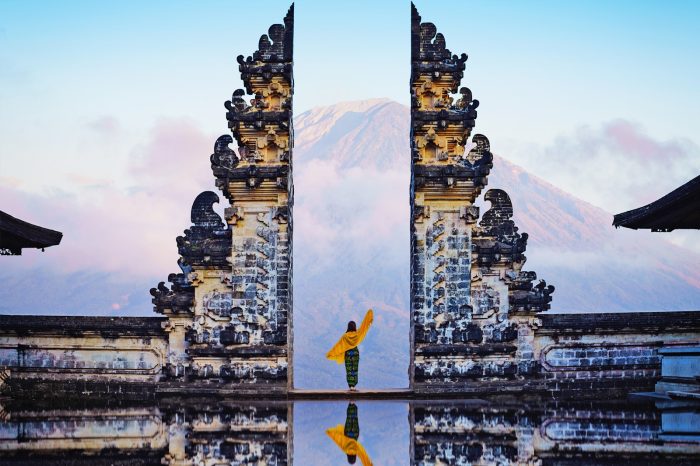
IDR 650K
Lempuyang Temple Bali Tour
Welcome to our Lempuyang Temple Bali Tour, a journey that will lead you past some of Bali’s most beautiful and famous sites. Our one-day tour package is made to provide you with a memorable experience that is packed with excitement, relaxation, and stunning surroundings.
Join Lempuyang Temple Bali Tour, also referred to as the “Gateway to Heaven,” and take a picture of you appearing to be heading upward with the spectacular Mount Agung in the background. The Tirta Gangga Water Palace, a magnificent royal residence with a labyrinth of ponds, fountains, and statues encircled by beautiful gardens, as well as the Tukad Cepung Waterfall, a hidden gem nestled away in a cave-like environment, will also be on our itinerary.
You will be led during the tour by one of our knowledgeable and personable tour guides, who will also make sure that you are secure and comfortable while giving you explicit consideration of Bali’s history and culture.
This Lempuyang Temple Bali Touris ideal for anyone seeking an adventure that combines Bali’s natural beauty and its extensive cultural legacy. So come and join Lempuyang Temple Bali Tour for a day that will leave you with lifelong memories that are truly unforgettable.
Place to Visit
Lempuyang Temple (Gate of Heaven)
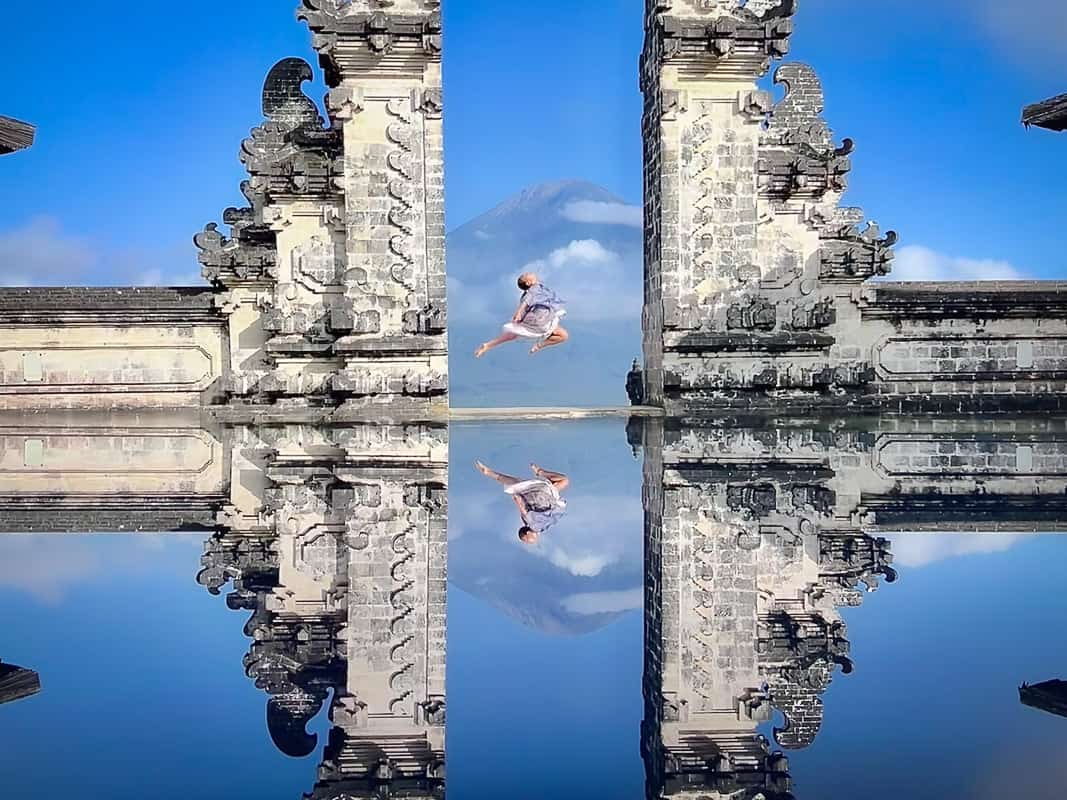
The complex of Balinese Hindu temples known as Lempuyang Temple is situated in East Bali, Indonesia. It is also referred to as Pura Lempuyang Luhur or the Gate of Heaven. It is located at an elevation of 1,175 meters above sea level on the slope of Mount Lempuyang and provides breathtaking views of the nearby hills and mountains.
Seven temples make up the complex, each of which is located on a different level and connected by a flight of stairs that leads to the main temple at the summit. Three imposing split gates, known as Candi Bentar and considered the entryway to the sacred sanctuary, mark the transition from the outside world to the inner realm of the gods in the main temple.
The Gate of Heaven, which is situated at the top of the stairs leading to the main temple, is the most well-known aspect of the Lempuyang Temple. The Gate of Heaven is a frame-like building that offers visitors a breathtaking photo opportunity by precisely framing the view of Mount Agung, Bali’s highest volcano.
Balinese Hindus consider the temple to be a significant place of worship and frequently come here to pray and make offerings to the gods. Guests are welcome to tour the temple grounds and observe the priests and worshippers performing their regular rituals.
The Lempuyang Temple entrance is free, but visitors must dress appropriately, which includes wearing a sarong and a sash. It’s also crucial to behave responsibly and avoid causing any disruptions in order to respect the temple and its holiness.
Tirta Gangga Water Palace
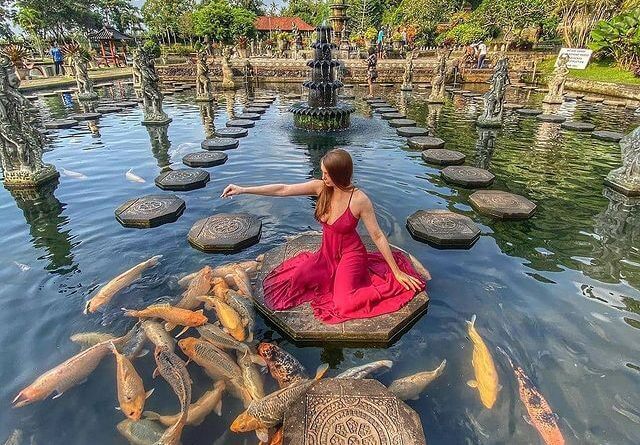
Tirta Gangga Water Palace is a popular major tourist destination in the eastern part of Bali, Indonesia. The palace was completed in 1946 by the last king of Karangasem, Anak Agung Anglurah Ketut Karangasem. It is a lovely complex of pools, fountains, and gardens nestled among lush green rice terraces and bordered by hills.
The water palace is notable for its gorgeous and elaborate Balinese architecture, which combines Hindu and Chinese elements. The palace is built around a natural spring that feeds three different pools, each with its own distinct personality and architecture.
The palace’s highlight is the first and largest pool, which is filled with crystal clear water teamed with koi fish. The second pool is the most sacred and is encircled by statues of mythical creatures. The third pool is a smaller, more secluded pool ideal for peaceful reflection and relaxation.
Aside from the pools, the palace has various exquisite fountains, stone carvings, and Hindu deity statues. The lovely gardens filled with brilliant flowers, coconut palms, and other tropical flora can be enjoyed by visitors as they stroll about the royal grounds.
Tirta Gangga Water Palace is not just a lovely tourist destination, but it also has cultural and religious significance for the Balinese. It is regarded as a spiritual healing center and is frequently utilized for religious ceremonies and rituals.
Tirta Gangga Water Palace is a must-see for anyone interested in Balinese culture and architecture, or who simply wants to escape the rush and bustle of daily life.
Tukad Cepung Waterfall
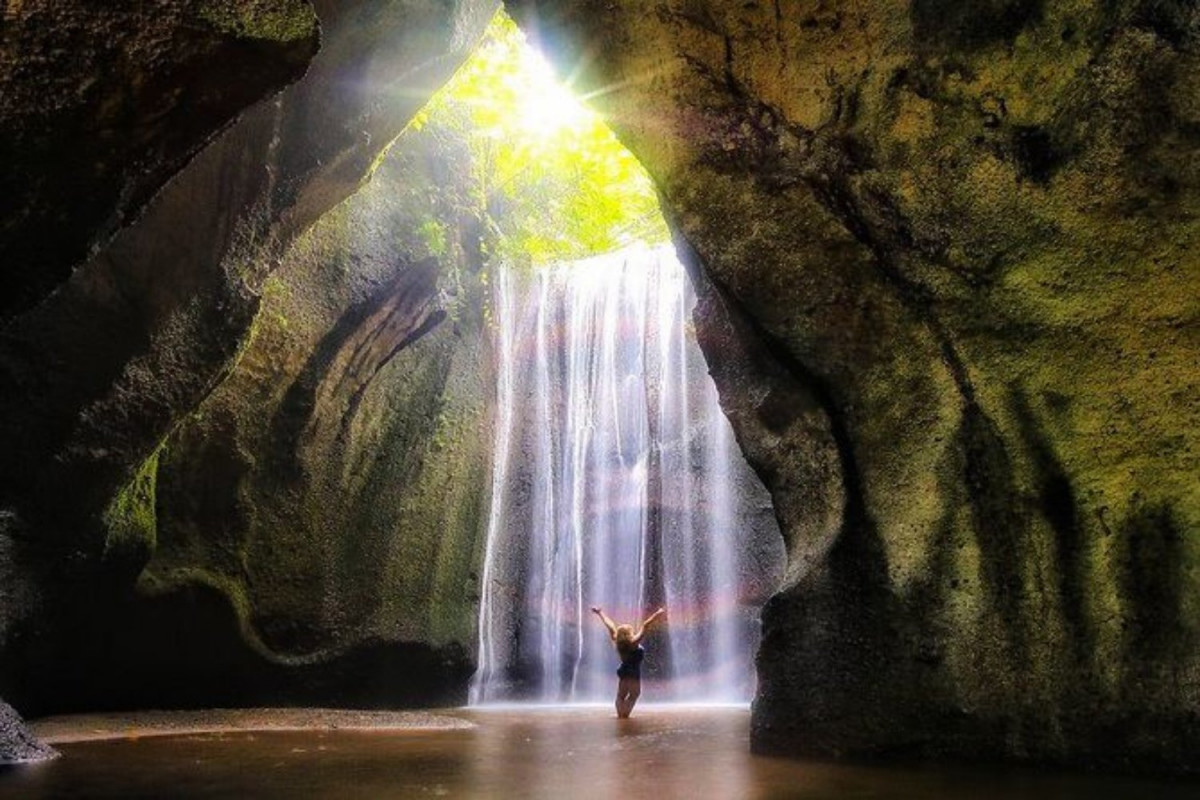
Tukad Cepung Waterfall is a hidden gem in Bali, Indonesia, located in the town of Tembuku, Bangli regency. It is a natural waterfall concealed inside a cave that is one of the island’s most remarkable and gorgeous waterfalls.
A stream passes through a short canyon and cascades into a pool below to make the waterfall. The waterfall is surrounded by steep rocks, and the sun’s rays filter through the narrow entrance of the cave, illuminating the cascade and the lake below.
Visitors must travel down a rough and slippery route through the lush jungle for about 15 minutes to reach the waterfall. The hike can be difficult, but it is well worth it for the breathtaking views of the waterfall and natural environs.
The greatest time to visit Tukad Cepung Waterfall is early in the morning when the sun’s rays are at their brightest and create the most magnificent light show. It is also less busy at this time, allowing tourists to experience the waterfall’s magnificence in private.
Guests can relax in the cool, soothing water of the pool below the waterfall. By the waterfall’s entrance, there are several tiny booths selling drinks and food.
Finally, Tukad Cepung Waterfall is a one-of-a-kind and spectacular location that nature enthusiasts and adventure seekers visiting Bali should not miss.
We appreciate your interest in our Lempuyang Temple Bali Tour! We think you’ll never forget your trip to the magnificent Lempuyang Temple (Gate of Heaven), the tranquil Tirta Gangga Water Palace, and the beautiful Tukad Cepung Waterfall. Your trip through the heart of Bali will be safe and unforgettable thanks to our skilled and hospitable guides.
Don’t pass it up this chance to see some of Bali’s most breathtaking sights. Make your reservation right away, and we’ll take you on an unforgettable journey!
Tour Itinerary
08:00 – Pick up at the hotel
11.00 – Visit Lempuyang Temple (Gate of Heaven)
13.00 – Visit Tirta Gangga Water Palace
14.00 – Lunch
15.30 – Visit Tukad Cepung Waterfall
16.30 – Back to the hotel
18.00 – Arrive at the hotel
Area Covered for Pick Up
Seminyak, Legian, Kuta, Nusa Dua, Jimbaran, Pecatu, Sanur, Ubud, Canggu, Denpasar, Benoa Harbour, Airport.
Please contact us for pick up in the different area.
Booking and Payment
- Fill in and submit the booking form
- Payment is Cash to your driver
1 day
